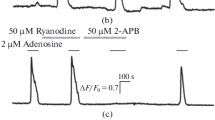Abstract
Calcium signaling induced by ATP in mesenchymal stromal cells (MSCs) from the human adipose tissue was studied by using the Ca2+ dye Fluo-4 and Ca2+ imaging. Previously, purinergic agonists have been found to mobilize Ca2+ in the MSC cytoplasm by stimulating IP3 production and triggering Ca2+ release from Ca2+ stores via IP3 receptors. Here we demonstrated that the phosphodiesterase inhibitor IBMX increased a lag period of ATP-induced Ca2+ responses and also shifted the dose–response curve to higher concentrations. When stimulated by ATP at doses close to the threshold concentration, MSCs became unresponsive in the presence of 50 μM IBMX. PKA inhibitor H89 did not restore MSC responsiveness to ATP lost in the presence of IBMX, while the application of KT-5823, a PKG inhibitor, canceled the inhibitory effect of IBMX. Yet, the cell treatment with KT-5823 resulted in a marked decrease in the ATP response delay. Altogether, the data obtained suggest that PKG modulates the MSC sensitivity to ATP, presumably by phosphorylating IP3 receptors in a cGMP-dependent manner.

Similar content being viewed by others
REFERENCES
Burnstock G. 2014. Purinergic signalling: From discovery to current developments. Exp. Physiol. 99, 16–34.
Verkhratsky A., Burnstock G. 2014. Biology of purinergic signalling: Its ancient evolutionary roots, its omnipresence and its multiple functional significance. BioEssays. 36, 697–705.
Zimmermann H., Zebisch M., Strater N. 2012. Cellular function and molecular structure of ecto-nucleotidases. Purinergic Sign. 8, 437–502.
Kotova P.D., Sysoeva V.Y., Rogachevskaja O.A., Bystrova M.F., Kolesnikova A.S., Tyurin-Kuzmin P.A., Fadeeva J.I., Tkachuk V.A., Kolesnikov S.S. 2014. Functional expression of adrenoreceptors in mesenchymal stromal cells derived from the human adipose tissue. Biochim. Biophys. Acta. 1843, 1899–1908.
Galle J., Hoffmann M., Krinner A. 2013. Mesenchymal stem cell heterogeneity and ageing in vitro: A model approach. In: Computational modeling in tissue engineering. Ed. Geris L. Berlin, Heidelberg: Springer, p. 183–205.
Phinney D.G. 2012. Functional heterogeneity of mesenchymal stem cells: Implications for cell therapy. J. Cell. Biochem. 113, 2806–2812.
Kotova P.D., Bystrova M.F., Rogachevskaja O.A., Khokhlov A.A., Sysoeva V.Yu., Tkachuk V.A., Kolesnikov S.S. 2018. Coupling of P2Y receptors to Ca2+ mobilization in mesenchymal stromal cells from the human adipose tissue. Cell Calcium. 71, 1–14.
Kotova P.D., Rogachevskaja O.A., Bystrova M.F., Kochkina E.N., Ivashin D.S., Kolesnikov S.S. 2018. Calcium signaling initiated by agonists in mesenchymal stromal cells from the human adipose tissue. In: Calcium and signal transduction. Ed. Buchholz J.N., London: IntechOpen, p. 139–163.
Berridge M.J., Bootman M.D., Roderick H.L. 2003. Calcium signalling: Dynamics, homeostasis and remodelling. Nat. Rev. Mol. Cell Biol. 4, 517–529.
Iino M. 2010. Spatiotemporal dynamics of Ca2+ signaling and its physiological roles. Proc. Japan Acad. Ser. B. Phys. Biol. Sci. 86, 244–256.
Rios E. 2018. Calcium-induced release of calcium in muscle: 50 years of work and the emerging consensus. J. Gen. Physiol. 150, 521–537.
Berridge M.J. 2016. The inositol trisphosphate/calcium signaling pathway in health and disease. Physiol. Rev. 96, 1261–1296.
Khokhlov A.A., Romanov R.A., Zubov B.V., Pashinin A.D., Kolesnikov S.S. 2007. Light emitting diode illuminator for the microphotometric study of cells. Pribory i tekhnika eksperimenta (Rus.). 3, 128–131.
Shah S.Z.A., Zhao D., Khan S.H., Yang L. 2015. Regulatory mechanisms of endoplasmic reticulum resident IP3 receptors. J. Mol. Neurosci. 56, 938–948.
Vanderheyden V., Devogelaere B., Missiaen L., De Smedt H., Bultynck G., Parys J.B. 2009. Regulation of inositol 1,4,5-trisphosphate-induced Ca2+ release by reversible phosphorylation and dephosphorylation. Biochim. Biophis. Acta 1793, 959–970.
Komalavilas P., Lincoln T.M. 1994. Phosphorylation of the inositol 1,4,5-trisphosphate receptor by cyclic GMP-dependent protein kinase. J. Biol. Chem. 269, 8701–8707.
Murthy K.S., Zhou H. 2003. Selective phosphorylation of the IP3R-I in vivo by cGMP-dependent protein kinase in smooth muscle. Am. J. Physiol. Gastr. Liver Physiol. 284, G221–G230.
Soulsby M.D., Wojcikiewicz R.J. 2005. The type III inositol 1,4,5-trisphosphate receptor is phosphorylated by cAMP-dependent protein kinase at three sites. Biochem. J. 392, 493–497.
Tertyshnikova T., Yan X., Fein A. 1998. cGMP inhibits IP3-induced Ca2+ release in intact rat megakaryocytes via cGMP- and cAMP-dependent protein kinases. J. Physiol. 512, 89–96.
Ammendola A., Geiselhoringer A., Hofmann F., Schlossmann J. 2001. Molecular determinants of the interaction between the inositol 1,4,5-trisphosphate receptor-associated cGMP kinase substrate (IRAG) and cGMP kinase Iβ. J. Biol. Chem. 276, 24 153–24 159.
ACKNOWLEDGMENTS
The work was supported by the Russian Science Foundation (project no. 18-14-00347).
Author information
Authors and Affiliations
Corresponding author
Ethics declarations
Conflict of interests. The authors declare that they have no conflict of interest.
Statement of compliance with standards of research involving humans as subjects. Informed consent was obtained from all individual participants involved in the study. All procedures were performed in accordance with the order of the RF Ministry of Health of August 11, 2017, no. 517n, and according to the recommendations of the WMA Helsinki Declaration (Declaration of Helsinki: Ethical Principles for Medical Research Involving Human Subjects, including amendments made by the 64th Meeting of WMA in Fortaleza, Brazil, October 2013).
Additional information
Translated by A. Dunina-Barkovskaya
Rights and permissions
About this article
Cite this article
Kochkina, E.N., Kotova, P.D., Enukashvily, N.I. et al. cGMP-Dependent Protein Kinase Modulates the Sensitivity of Mesenchymal Stromal Cells to Purinergic Agonists. Biochem. Moscow Suppl. Ser. A 13, 283–287 (2019). https://doi.org/10.1134/S1990747819030152
Received:
Revised:
Accepted:
Published:
Issue Date:
DOI: https://doi.org/10.1134/S1990747819030152




